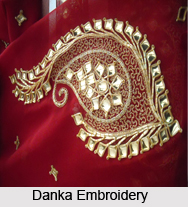 Danke ka kaam is a specialty in terms of metal embroidery of places like Udaipur and neighbouring areas. This craft is particularly distinguished by the use of a small, metallic square around which the zardozi work is usually done.
Danke ka kaam is a specialty in terms of metal embroidery of places like Udaipur and neighbouring areas. This craft is particularly distinguished by the use of a small, metallic square around which the zardozi work is usually done.
The danka is a small square plate, which is variable in size but is not bigger than 1.5 cm. This method was earlier also known as korpatti-ka-kaam. Although the danka was originally made from pure gold, silver plated with gold, is usually used these days. Previously, danka was also made with superior silver sheet, which was first warmed and then gold foil that was applied to its surface and pressed. Of late, well-finished, polished thin silver sheets of 98% purity are electroplated with gold in strips of 30 cm. by 2.5 cm. These are then washed in plain water and polished once again with excellent granular sand. The strip is then cut into 1.25 cm. squares. The cost of the Danke ka kaam is calculated according to its weight.
This decorative technique is usually worked on fabrics like satin, chiffon or silk fabric. The fabric is stretched tightly on a wooden frame before it is embroidered and the craftsman sits on the floor. Danka pieces are spread on the fabric as required by the design. The danka is pierced with a sharp needle, bringing out the thread through the fabric. About three to five strands of kasab (gold or silver wire) are kept over each danka and couched down along its edges. It is secured with eight stitches in the shape of a knot. Two stitches go into the back and the other two at each corner and two on the front. Round and flat metal braids about one quarter of a centimetre in width that are used to highlight the design. Additional stitches used include the chain stitch, satin stitch for the design filling, while stem and running stitches are for lighter work. The most popular motifs used in Danke ka kaam are inspired by nature, like the paisley, which takes a stylised form, alike the sun and the moon.





















